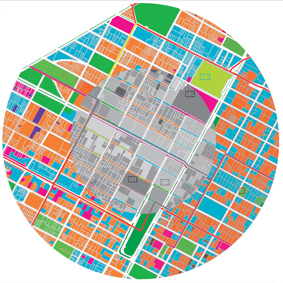Comments based on the questions of the blog post “Architecture & Happiness” 
“The diversity and mixed use of the space for increased the diversity of the city, in order to create new activities and typologies”
Diagram of Mixed Use of the Space, by Trinidad Gómez and Miguel Juárez.
With the past of the time, the word “sustainability” have changed depending on the place in which will be developed or because of the people that is applying this concept; this way of thinking has always existed, people from faraway communities, little towns or without enough resources, have always been self-sufficiency and have found several ways to live only with what they have in the surrounding space; the only thing that have changed is that in the modern era took a great importance and the architects, urban developers or anyone involved in the design process, tried to apply into a big scale, like cities, thanks to this, buildings, communities, colonies, and every kind of new infrastructure, began to be designed with new materials, technologies and resources; the problem that surged after this new development, was that the plus value of the buildings increased and it only could be affordable for people with highs amount of money, besides that almost all of this projects were made in super expensive areas. In the contemporary era, the New Urbanism emerged and with it new ways of thinking were applied in the city, with this theme is which I will respond the first question of the blog post; I do not think that we can separate buildings out from the infrastructure of cities and mobility of transit and the expectations and incentives of people; I believe that the answer lies in the correct integration of these elements without to forget the main actor for we are designing: people. Applying concepts like the ones in New Urbanism, we can create a system that works with everything and for everyone; the urban connectivity which consist in connect different points of the city to achieve a faster communication and to avoid the pollution because of traffic; urban spaces have to be designed to be walkable spaces, not for private motorized vehicles; the diversity and mixed use of the space for increased the diversity of the city, in order to create new activities and typologies; and the most important ones: an intelligent urban transport that maximized the resources for an efficient connectivity; the other, an urban sustainability not only in environmental aspects, but also in economic, politic and social aspects; all this to accomplishes an adequate use of the available elements in benefit of the community. 
“The urban connectivity which consist in connect different points of the city to achieve a faster communication and to avoid the pollution because of traffic”
Diagram of Urban Connectivity, by Trinidad Gómez and Miguel Juárez.
With this explanation, I can continue with my opinion of the second question phrased by Gonzalo Delacámara: Why do people tend to believe that what is financially profitable (for developers) is not actually equivalent to economically feasible (positive impacts on social welfare)? How would you show that this does not necessarily have to be like this (but rather the opposite)? I believe that the problem lies in the fact that people feels cheated by certain kind of “developers” who only cares about money, instead for a good site analysis that allowed a good project; another problem is that constructors, urbanists, designers, politics, etc., always wants to create the perfect place starting from zero, instead of interventions inside the city to avoid the boundless growing of the urban sprawl. How would I show to people that what is financially profitable for developers is equivalent to a positive impact on social welfare? With Curitiba, Brazil, the most remarkable example of a city (in my personal point of view) that achieved positive impacts on social welfare, an equitative economy and a correct growing of the city by using Transit Oriented Development, or TOD. 
“Accessible public transportation is prioritized when choosing housing and commercial building locations”
Diagram of TOD, by Trinidad Gómez and Miguel Juárez.
Curitiba is an excellent example of TOD, which mainly implies that residential, business and recreational areas should be built in high density areas and close to public transport stations. In addition, TOD proposes land use mix to reduce the travel distances. Accessible public transportation is prioritized when choosing housing and commercial building locations. High traffic areas such as shopping centers and high rise apartment buildings are conveniently located next to public transportation stations. This level of accessibility has reduced automobile dependence. By coupling the development of a pedestrian friendly community with an efficient low-emissions Bus Rapid Transit (BRT) system and lower car parking availability, Curitiba has successfully reduced the overall travel of its residents. With the correct formula we can achieve not only an economical sustainability, but also a political, environmental and social sustainability. It depends on the “how?” and the “why?” always having present the “for who?” For sure Curitiba is not the only successful example in the world, but it is one of the most advanced. The secret lies in to keep developing strategies according to the changes in the city, because we cannot forget that the city is alive and always evolving.